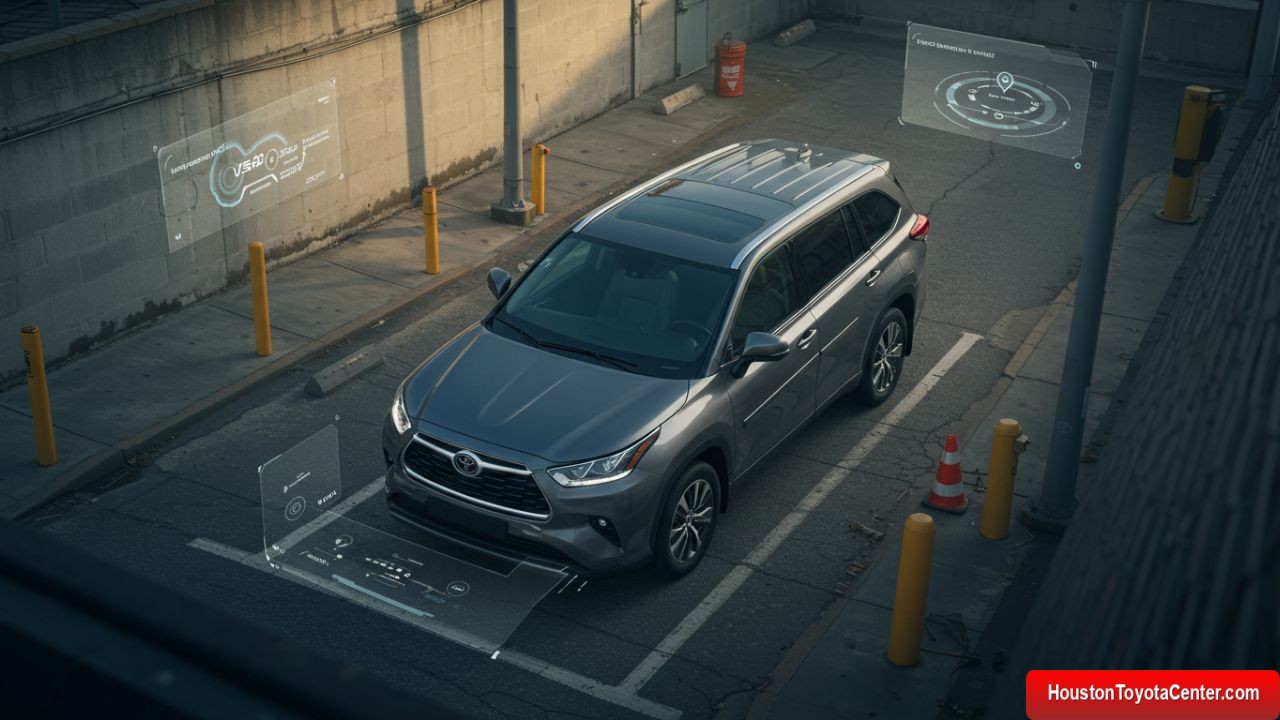When it comes to driving in today’s complex urban and suburban environments, safety and visibility are key. One of Toyota’s most cutting-edge driver-assist technologies, the Panoramic View Monitor (PVM), is changing how drivers interact with their surroundings. By offering a full 360-degree view around the vehicle, this system gives drivers unparalleled spatial awareness and boosts confidence behind the wheel—especially in tight spaces.
Whether you’re maneuvering into a narrow parking spot, navigating through busy streets, or avoiding obstacles off-road, Toyota’s Panoramic View Monitor is your ultimate co-pilot.
What Is the Panoramic View Monitor?
Toyota’s Panoramic View Monitor is an advanced surround-view camera system that stitches together real-time video feeds from four strategically placed cameras around the vehicle:
- Front grille camera
- Under each side mirror
- Rear bumper camera
These feeds are merged into a single bird’s-eye composite view, which is then displayed on the vehicle’s infotainment screen. This makes it seem as though you are viewing the car from directly above—a perspective that revolutionizes driver awareness.
FREE: Quickly identify and understand problems with your vehicle 🚘
CLICK HEREThe system is designed to eliminate blind spots, enhance parking accuracy, and aid in tricky navigation scenarios.
Key Features of Toyota’s Panoramic View Monitor
| Feature | Description |
|---|---|
| 360-Degree Bird’s-Eye View | Seamless top-down video view from all sides of the vehicle |
| Split-Screen Options | Multiple angles including front, rear, side, and composite views |
| Moving View Mode | Simulates camera movement around the car while stationary |
| See-Through View | Gives a transparent overlay of the vehicle to visualize ground surroundings |
| Obstacle Detection | Highlights nearby objects to assist during tight maneuvers |
| Guidelines | Dynamic gridlines that adjust with steering input to show projected paths |
How It Works: Technology Under the Hood
Toyota’s Panoramic View Monitor relies on high-resolution, wide-angle cameras and powerful image processing software. Here’s a simplified breakdown:
- Capture: Cameras mounted at four locations continuously record the environment.
- Processing: Images are processed in real-time by an onboard computer system that corrects distortion and aligns angles.
- Stitching: All feeds are stitched together into a seamless, panoramic view using complex algorithms.
- Display: The resulting image is displayed on the infotainment screen with optional guidelines and alerts.
Advanced sensor fusion, where camera data is cross-referenced with ultrasonic parking sensors, further increases the system’s accuracy and effectiveness.
Real-Life Scenarios Where PVM Shines
✦ Parallel Parking in the City
Even for experienced drivers, parallel parking in a tight urban space can be stressful. With the 360-degree top-down view, you can easily monitor your position relative to curbs, other vehicles, and pedestrians.
✦ Navigating Drive-Thrus or Car Washes
Some car washes and drive-thrus have tight lanes or curbs. The side cameras allow you to keep an eye on your wheels, reducing the chance of scratches or alignment damage.
✦ Off-Roading or Trail Driving
In rugged terrain, ground visibility is critical. The see-through feature helps drivers navigate over rocks, dips, or tree stumps by visualizing the terrain under the vehicle.
✦ Backing Out of a Crowded Parking Lot
The rear and side views show oncoming traffic and pedestrians, reducing the risk of accidents in busy shopping centers.
Models Equipped with the Panoramic View Monitor
While not every Toyota comes standard with this feature, it’s increasingly available across the lineup—especially in higher trims or as part of upgrade packages.
| Model | Availability |
|---|---|
| Toyota Highlander | Standard on Platinum trim |
| Toyota RAV4 | Available on Limited and Prime XSE trims |
| Toyota Tundra | Standard on 1794, Platinum, and TRD Pro |
| Toyota Sienna | Available on XSE and Limited trims |
| Toyota Sequoia | Standard on Capstone and TRD Pro |
| Toyota Venza | Standard on Limited trim |
Integration with Other Safety Technologies
The Panoramic View Monitor isn’t a standalone safety system. It integrates with other Toyota safety technologies to provide an even more comprehensive safety net:
- Toyota Safety Sense™ (TSS): Works in tandem with systems like Pre-Collision System, Lane Departure Alert, and Dynamic Radar Cruise Control.
- Parking Assist Sensors: Supplement the visual system with audible alerts.
- Rear Cross-Traffic Alert (RCTA): Warns you of approaching vehicles as you reverse.
- Blind Spot Monitor (BSM): Covers the side areas that even cameras might miss.
A Closer Look at the Interface
Toyota’s user interface for PVM is designed to be intuitive, allowing drivers to toggle between views with just a tap.
- Touchscreen View Selector: Lets you choose angles manually (front, side, rear, top-down).
- Auto Activation: The system automatically turns on when you put the car in reverse or drive at low speeds near obstacles.
- Split-View Functionality: Displays different camera angles side by side.
- Steering-Sensitive Guidelines: These dynamic lines show where the car is heading based on your current steering input.
This user-friendly design ensures that drivers get the information they need without distraction.
Benefits Beyond Parking
While parking assistance is a primary function, the Panoramic View Monitor also enhances:
- Driver Confidence: Knowing you have a clear picture of your surroundings increases comfort in tight situations.
- Safety for Passengers and Pedestrians: Reduced blind spots mean fewer chances of hitting unseen obstacles or people.
- Vehicle Longevity: Avoiding scrapes, dents, and tire damage helps preserve the car’s resale value.
Comparison: Toyota’s PVM vs. Competitor Systems
| Brand | Feature Name | Notable Differences |
|---|---|---|
| Toyota | Panoramic View Monitor | Includes moving/see-through views |
| Honda | Multi-Angle Rearview Camera | Rear view only with selectable angles |
| Nissan | Intelligent Around View Monitor | Similar features, slightly lower resolution |
| Ford | 360-Degree Camera | Lacks “moving view” simulation |
| Hyundai | Surround View Monitor | Basic top-down, fewer customization options |
Toyota’s edge lies in how polished and seamlessly integrated its system is—not just in visuals, but also in user experience and safety enhancement.
Customer Testimonials
“It’s like having a drone view of my car every time I park. Total game changer!”
— Karen M., Toyota Highlander owner
“I used to dread city parking, but now I just glide in. I can even see the curb perfectly.”
— Leonard G., Toyota RAV4 Prime driver
“This should be standard on every car. It’s not just a luxury—it’s a safety feature.”
— Ashley R., Toyota Sienna XSE parent of two
Future of Panoramic Safety
As Toyota continues to develop autonomous and semi-autonomous features, technologies like the Panoramic View Monitor are foundational. Expect to see enhancements such as:
- AI-driven obstacle prediction
- Augmented reality overlays
- Integration with fully autonomous parking systems
The Panoramic View Monitor is a bridge between human control and machine awareness, helping drivers today while laying the groundwork for the cars of tomorrow.
Final Thoughts
Toyota’s Panoramic View Monitor is more than just a flashy tech feature—it’s a powerful safety tool that enhances visibility, reduces stress, and helps drivers make smarter decisions in real time. As urban environments become more congested and drivers demand more peace of mind, the 360-degree safety offered by PVM could soon become the new standard.
For those who value confidence, precision, and control—whether in a RAV4, Highlander, Sienna, or Tundra—Toyota’s Panoramic View Monitor delivers unmatched clarity.


Leave a Reply